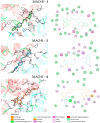Coumarin Derivative Hybrids: Novel Dual Inhibitors Targeting Acetylcholinesterase and Monoamine Oxidases for Alzheimer's Therapy
- PMID: 39684512
- PMCID: PMC11641184
- DOI: 10.3390/ijms252312803
Coumarin Derivative Hybrids: Novel Dual Inhibitors Targeting Acetylcholinesterase and Monoamine Oxidases for Alzheimer's Therapy
Abstract
Multi-target-directed ligands (MTDLs) represent a promising frontier in tackling the complexity of multifactorial pathologies like Alzheimer's disease (AD). The synergistic inhibition of MAO-B, MAO-A, and AChE is believed to enhance treatment efficacy. A novel coumarin-based molecule substituted with O-phenylpiperazine via three- and four-carbon linkers at the 5- and 7-positions, has been identified as an effective MTDL against AD. Employing a medicinal chemistry approach, combined with molecular docking, molecular dynamic simulation, and ΔGbind estimation, two series of derivatives emerged as potent MTDLs: 8-acetyl-7-hydroxy-4-methylcoumarin (IC50: 1.52-4.95 μM for hAChE, 6.97-7.65 μM for hMAO-A) and 4,7-dimethyl-5-hydroxycoumarin (IC50: 1.88-4.76 μM for hMAO-B). They displayed binding free energy (ΔGbind) of -76.32 kcal/mol (11) and -70.12 kcal/mol (12) against AChE and -66.27 kcal/mol (11) and -62.89 kcal/mol (12) against MAO-A. It is noteworthy that compounds 11 and 12 demonstrated efficient binding to both AChE and MAO-A, while compounds 3 and 10 significantly reduced MAO-B and AChE aggregation in vitro. These findings provide structural templates for the development of dual MAO and AChE inhibitors for the treatment of neurodegenerative diseases.
Keywords: Alzheimer’s disease; coumarin derivatives; hAChE/hMAO-B dual-targeted inhibitor; molecular docking; molecular dynamic simulation.
Conflict of interest statement
The authors declare no conflicts of interest.
Figures










Similar articles
-
Coumarin-dithiocarbamate hybrids as novel multitarget AChE and MAO-B inhibitors against Alzheimer's disease: Design, synthesis and biological evaluation.Bioorg Chem. 2018 Dec;81:512-528. doi: 10.1016/j.bioorg.2018.09.010. Epub 2018 Sep 11. Bioorg Chem. 2018. PMID: 30245233
-
Synthesis, characterization, molecular docking and molecular dynamics simulations of novel 2,5-disubstituted-1,3,4-thiadiazole derivatives as potential cholinesterase/monoamine oxidase dual inhibitors for Alzheimer's disease.J Biomol Struct Dyn. 2024;42(23):13023-13041. doi: 10.1080/07391102.2023.2274967. Epub 2023 Nov 1. J Biomol Struct Dyn. 2024. PMID: 37909464
-
ML-based prediction to experimental validation: Development of dihydroquinazoline based multi-potent ligands as anti-Alzheimer's agents.Comput Biol Med. 2025 Sep;196(Pt A):110762. doi: 10.1016/j.compbiomed.2025.110762. Epub 2025 Jul 14. Comput Biol Med. 2025. PMID: 40664126
-
Latest advances in dual inhibitors of acetylcholinesterase and monoamine oxidase B against Alzheimer's disease.J Enzyme Inhib Med Chem. 2023 Dec;38(1):2270781. doi: 10.1080/14756366.2023.2270781. Epub 2023 Nov 13. J Enzyme Inhib Med Chem. 2023. PMID: 37955252 Free PMC article. Review.
-
Repurposing of FDA-approved drugs as dual-acting MAO-B and AChE inhibitors against Alzheimer's disease: An in silico and in vitro study.J Mol Graph Model. 2023 Jul;122:108471. doi: 10.1016/j.jmgm.2023.108471. Epub 2023 Apr 14. J Mol Graph Model. 2023. PMID: 37087882 Review.
Cited by
-
Synthesis, Biological Evaluation, and Molecular Docking Studies of Novel Coumarin-Triazole-Isatin Hybrids as Selective Butyrylcholinesterase Inhibitors.Molecules. 2025 May 11;30(10):2121. doi: 10.3390/molecules30102121. Molecules. 2025. PMID: 40430294 Free PMC article.
-
Structural Bioinformatics Applied to Acetylcholinesterase Enzyme Inhibition.Int J Mol Sci. 2025 Apr 17;26(8):3781. doi: 10.3390/ijms26083781. Int J Mol Sci. 2025. PMID: 40332446 Free PMC article. Review.
References
-
- Li Y., Qiang X., Luo L., Yang X., Xiao G., Liu Q., Ai J., Tan Z., Deng Y. Aurone Mannich base derivatives as promising multifunctional agents with acetylcholinesterase inhibition, anti-beta-amyloid aggragation and neuroprotective properties for the treatment of Alzheimer’s disease. Eur. J. Med. Chem. 2017;126:762–775. doi: 10.1016/j.ejmech.2016.12.009. - DOI - PubMed
MeSH terms
Substances
LinkOut - more resources
Full Text Sources
Medical

